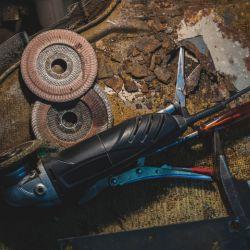Rust is a common problem that affects various metallic objects, causing deterioration and reducing their lifespan. Traditional methods of rust removal often involve labor-intensive processes such as scraping, sanding, or the use of chemical agents. However, a newer and more efficient method has emerged in recent years – the laser rust removal tool. In this article, we will explore how this innovative tool works and discuss its advantages over traditional rust removal methods.
- Understanding Laser Rust Removal:
Laser rust removal is a non-abrasive technique that utilizes high-energy laser beams to remove rust from metal surfaces. The process involves directing a focused laser beam onto the rusted area, which rapidly heats and vaporizes the rust. As the rust evaporates, it is converted into a gaseous state, leaving behind a clean metal surface.
- How Does the Laser Rust Removal Tool Work?
The Laser Rust Removal Tool consists of several key components:
a. Laser Source: The laser source generates the high-energy laser beam used for rust removal. It emits a concentrated beam of light with a specific wavelength that is absorbed by the rusted surface, allowing for efficient rust removal.
b. Scanning System: The scanning system directs and moves the laser beam across the rusted surface in a controlled manner. This ensures that the laser covers the entire affected area and avoids unnecessary damage to the surrounding material.
c. Cooling System: The laser rust removal process generates significant heat, so a cooling system is incorporated to prevent the laser from overheating. This ensures the tool's longevity and enables continuous operation.
- Advantages of Laser Rust Removal:
Laser rust removal offers several notable advantages over traditional rust removal methods:
a. Non-Destructive: Unlike traditional methods that involve scraping or sanding, laser rust removal is a non-contact process that does not physically touch the metal surface. This eliminates the risk of surface damage, such as scratches or dents, which can compromise the structural integrity of the object.
b. Precision and Selectivity: The laser beam can be precisely controlled and focused on the rusted area, allowing for selective rust removal. This means that the laser can target only the rust, leaving the unaffected metal surface intact. This level of precision is particularly beneficial for intricate or delicate objects where traditional methods may be challenging or impractical to apply.
c. Efficiency and Speed: Laser rust removal is a highly efficient process that can remove rust quickly and effectively. The high-energy laser beam rapidly vaporizes the rust, reducing the need for time-consuming manual labor. This makes laser rust removal particularly advantageous for large-scale industrial applications, where time and cost savings are paramount.
d. Environmental Friendliness: Traditional rust removal methods often involve the use of harsh chemicals that can be harmful to both human health and the environment. Laser rust removal, on the other hand, is a clean and eco-friendly process. It does not generate hazardous fumes or produce chemical waste, making it a more sustainable choice.
e. Versatility: Laser rust removal can be applied to a wide range of metals, including steel, iron, aluminum, and copper. This versatility makes it a valuable tool in various industries, such as automotive, aerospace, marine, and manufacturing, where rust is a common problem.
- Limitations and Considerations:
While laser rust removal offers numerous advantages, there are a few limitations and considerations to keep in mind:
a. Cost: Laser rust removal tools can be expensive to acquire and maintain compared to traditional rust removal methods. The initial investment in the equipment and the ongoing maintenance costs should be taken into account when considering this technology.
b. Safety Measures: Laser beams can be hazardous if not handled with care. Proper safety measures, including the use of protective eyewear and following operational guidelines, are essential to ensure the safety of operators and bystanders.
c. Surface Preparation: Laser rust removal works best on relatively flat or smooth surfaces. Rough or uneven surfaces may require additional surface preparation to achieve optimal results.
d. Rust Depth: Laser rust removal is most effective for surface-level rust. If the rust has penetrated deeply into the metal, additional treatments or alternative methods may be required to fully restore the object.
Conclusion:
Laser rust removal is a cutting-edge technology that offers significant advantages over traditional rust removal methods. Its non-destructive nature, precision, efficiency, environmental friendliness, and versatility make it an appealing choice for various industries. While there are limitations and considerations to be aware of, the overall benefits of laser rust removal make it a powerful tool in the ongoing battle against rust, extending the lifespan of metal objects and contributing to their overall maintenance and preservation.
